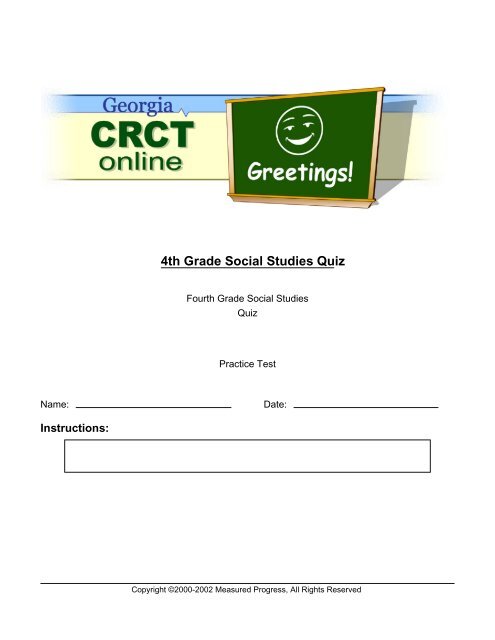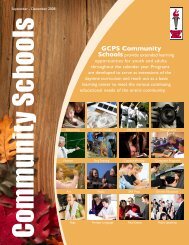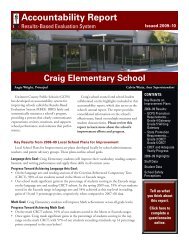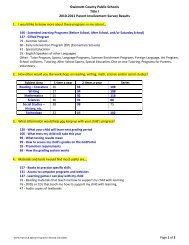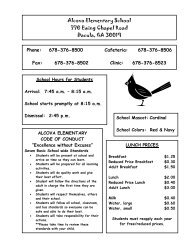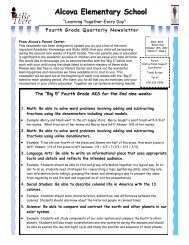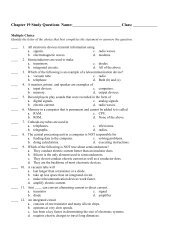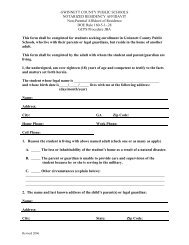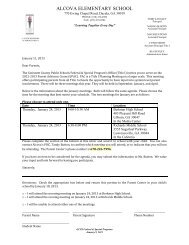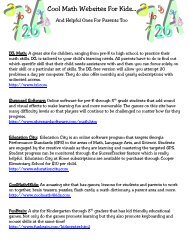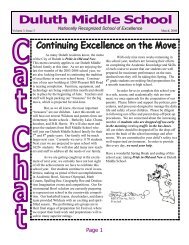Create successful ePaper yourself
Turn your PDF publications into a flip-book with our unique Google optimized e-Paper software.
<strong>4th</strong> <strong>Grade</strong> <strong>Social</strong> <strong>Studies</strong> <strong>Quiz</strong><br />
Fourth <strong>Grade</strong> <strong>Social</strong> <strong>Studies</strong><br />
<strong>Quiz</strong><br />
Practice Test<br />
Name:<br />
Date:<br />
Instructions:<br />
Copyright ©2000-2002 Measured Progress, All Rights Reserved
Name:<br />
Date:<br />
<strong>Quiz</strong>:<br />
Teacher:<br />
<strong>4th</strong> <strong>Grade</strong> <strong>Social</strong> <strong>Studies</strong> <strong>Quiz</strong><br />
Practice Test<br />
1. What was the name of the woman in Georgia who held six British soldiers at gunpoint after preparing<br />
a meal for them?<br />
A. Nancy Hart<br />
B. Abigail Adams<br />
C. Harriet Tubman<br />
D. Mercy Otis Warren<br />
Fourth <strong>Grade</strong> <strong>Social</strong> <strong>Studies</strong><br />
2<br />
<strong>Quiz</strong>
Name:<br />
Date:<br />
<strong>Quiz</strong>:<br />
Teacher:<br />
<strong>4th</strong> <strong>Grade</strong> <strong>Social</strong> <strong>Studies</strong> <strong>Quiz</strong><br />
Practice Test<br />
Use the maps below to answer question 2.<br />
2. Look at the physical map and the map of the original 13 colonies. Which physical feature did MOST<br />
of the Southern colonies have in common?<br />
Fourth <strong>Grade</strong> <strong>Social</strong> <strong>Studies</strong><br />
3<br />
<strong>Quiz</strong>
Name:<br />
Date:<br />
<strong>Quiz</strong>:<br />
Teacher:<br />
<strong>4th</strong> <strong>Grade</strong> <strong>Social</strong> <strong>Studies</strong> <strong>Quiz</strong><br />
Practice Test<br />
A. Rocky Mountains<br />
B. Coastal Plains<br />
C. Great Lakes<br />
D. Gulf of St. Lawrence<br />
3. The way of living of Eastern Woodlands Native Americans depended on the resources in their area.<br />
This can be seen in their shelters, which were called longhouses. They were built from wood and<br />
bark. This type of shelter was common because<br />
A. other types of shelters cost too much to build.<br />
B. the materials of wood and bark were available from the forest.<br />
C. other types of shelters could not protect them.<br />
D. the wood and bark could not be destroyed or damaged.<br />
Fourth <strong>Grade</strong> <strong>Social</strong> <strong>Studies</strong><br />
4<br />
<strong>Quiz</strong>
Name:<br />
Date:<br />
<strong>Quiz</strong>:<br />
Teacher:<br />
<strong>4th</strong> <strong>Grade</strong> <strong>Social</strong> <strong>Studies</strong> <strong>Quiz</strong><br />
Practice Test<br />
4. When Europeans began exploring North and South America, they came into contact with Native<br />
Americans. Which statement BEST describes what the Europeans believed about them?<br />
A. They believed the Native Americans were better than Europeans.<br />
B. They believed the Europeans were better than Native Americans.<br />
C. They believed that Native Americans should receive money for the land.<br />
D. They believed that Native Americans should keep all of their land.<br />
5. The Boston Tea Party made many people in Great Britain angry. As a result, Parliament passed the<br />
Coercive or Intolerable Acts. One purpose of these acts was to<br />
A. let the colonists choose whether or not to buy tea.<br />
B. force the colonists to purchase tea from Great Britain.<br />
C. close the port of Boston as a punishment for its citizens.<br />
D. capture ships that brought tea from other countries.<br />
6. In the 1600s, the Dutch started colonies in North America, near what is today New York. What was<br />
the main reason the Dutch started these colonies?<br />
A. They wanted to locate the Northwest Passage.<br />
B. They wanted to spread their religion to North America.<br />
C. They wanted to control the trade in that area.<br />
D. They wanted to find the Fountain of Youth.<br />
7. Which group of Native Americans often followed buffalo in order to help feed, cloth, and house<br />
themselves?<br />
A. Plains<br />
B. Southwestern<br />
C. Pacific Northwest<br />
D. Eastern Woodlands<br />
Fourth <strong>Grade</strong> <strong>Social</strong> <strong>Studies</strong><br />
5<br />
<strong>Quiz</strong>
Name:<br />
Date:<br />
<strong>Quiz</strong>:<br />
Teacher:<br />
<strong>4th</strong> <strong>Grade</strong> <strong>Social</strong> <strong>Studies</strong> <strong>Quiz</strong><br />
Practice Test<br />
8. During the Revolutionary War, some colonists were called Patriots and other colonists were called<br />
Loyalists. Which of the following BEST states a Loyalist’s point of view?<br />
A. The colonists should not be paying taxes on tea.<br />
B. The colonists should sign the Declaration of Independence<br />
C. The colonists should stop buying British goods.<br />
D. The colonists should stop complaining about the king of England.<br />
9. The physical environment affected the lives of Native Americans. Which one of the following<br />
activities best describes some of the Native Americans of the Eastern Woodlands?<br />
A. They hunted buffalo and deer on the plains.<br />
B. They built longhouses out of bark.<br />
C. They fished salmon in the rivers.<br />
D. They grew cotton and tobacco in the fields.<br />
10. The British colonies in North America were settled for different reasons. The colony of Pennsylvania<br />
was settled in the 1600s as a place for<br />
A. people of different races, especially Africans.<br />
B. only people who knew a trade or business.<br />
C. people of different beliefs, especially Quakers.<br />
D. only people who had money and titles in England.<br />
11. Who in the U.S. government has the power to override vetoes?<br />
A. the president<br />
B. the Congress<br />
C. the cabinet<br />
D. the Supreme Court<br />
Fourth <strong>Grade</strong> <strong>Social</strong> <strong>Studies</strong><br />
6<br />
<strong>Quiz</strong>
Name:<br />
Date:<br />
<strong>Quiz</strong>:<br />
Teacher:<br />
<strong>4th</strong> <strong>Grade</strong> <strong>Social</strong> <strong>Studies</strong> <strong>Quiz</strong><br />
Practice Test<br />
12. In 1776, the Continental Congress approved a document that stated governments do not have the<br />
right to take away a citizen’s “Life, Liberty, and Pursuit of Happiness.” What was this document<br />
called?<br />
A. The Constitution<br />
B. Common Sense<br />
C. The Articles of Confederation<br />
D. The Declaration of Independence<br />
13. The Bill of Rights contains certain basic freedoms guaranteed to Americans. One is freedom of<br />
speech. Which of the following is an example of freedom of speech?<br />
A. John can voice his opinions about which presidential candidate he supports.<br />
B. May can decide if she would like to attend a church this weekend.<br />
C. Carlos can join a march against placing a road through the park.<br />
D. Misti can read an article in the newspaper that discusses waste in government.<br />
14. The War of 1812 was fought between the United States and Great Britain. The MAIN reason why<br />
this war was fought was<br />
A. to win freedom from Great Britain.<br />
B. to stop British attacks on American cities on the coast.<br />
C. to protect the right to trade with anyone.<br />
D. to keep Native Americans on reservations.<br />
15. Which of the following jobs would MOST LIKELY be identified with the Northeast?<br />
A. cattle rancher<br />
B. corn farmer<br />
C. diamond miner<br />
D. lobster fisherman<br />
Fourth <strong>Grade</strong> <strong>Social</strong> <strong>Studies</strong><br />
7<br />
<strong>Quiz</strong>


